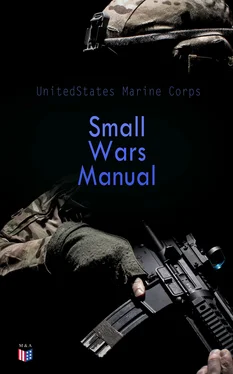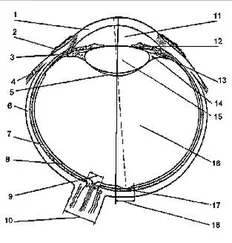6-99. Night operations.
CHAPTER VII MOUNTED DETACHMENTS
SECTION I INTRODUCTION
7-1. Purpose.
7-2. Use of animals an expedient.
7-3. Need for training in animal care and employment.
7-4. Some difficulties in employing animals.
SECTION II CARE OF ANIMALS
7-5. Knowledge of animal management required.
7-6. Nomenclature.
7-7. Identification.
7-8. Duties of officers charged with care of animals.
7-9. Rules for handling animals.
7-10. Stableo and corrals.
7-11. Grooming.
7-12. Forage.
7-13. Principles of feeding.
7-14. Watering.
7-15. Conditioning.
7-16. Management of animals on the march.
7-17. First-aid treatment.
7-18. Communicable diseases.
7-19. Care of the feet.
7-20. Veterinary supplies.
SECTION III PROCUREMENT OF ANIMALS
7-21. Necessity for local purchase.
7-22. Procurement agents.
7-23. Native dealers.
7-24. Purchasing from native dealers.
7-25. Minimum specifications for animals.
7-27. Age qualifications.
7-28. Examination for soundness.
7-29. Marking of purchased animals.
7-30. Use of United States animals in small wars.
SECTION IV MOUNTED DETACHMENTS
7-31. Value of mounted detachments.
7-32. Basis for organization.
7-33. A mounted rifle company.
7-34. Machine-gun and howitzer units.
7-35. Animals for mounted detachments.
7-36. Spare mounts.
7-37. Assignment of mounts.
7-38. Horse equipment.
7-39. Individual equipment.
7-40. Arms and ammunition.
7-41. Pack equipment.
7-42. Training, general.
7-43. Training for specialists.
7-44. Time required for training.
7-45. Combat training.
7-46. Tactical uses of mounted detachments.
7-47. Conduct of mounted patrols.
7-48. Combat patrols.
7-49. Ambushes.
SECTION V HASTILY ORGANIZED MOUNTED PATROLS
7-50. Definition and uses.
7-51. Discussion.
7-52. Type of animal to employ.
7-53. Other details.
CHAPTER VIII CONVOYS AND CONVOY ESCORTS
8-1. Definitions.
8-2. Mission.
8-3. Organization.
8-4. Convoy types.
8-5. March of convoys.
8-6. Disposition of the escort on the march.
8-7. Defehse of a convoy.
8-8. Attack of a convoy.
8-9. Security measures at the halt.
CHAPTER IX AVIATION
SECTION I INTRODUCTION
9-1. General.
9-2. Special air tactics involved.
SECTION II COMPOSITION AND ORGANIZATION
9-3. Types.
9-4. Reconnaissance aircraft.
9-5. Combat aircraft.
9-6. Transport aircraft.
9-7. Organization.
9-8. Movement to the theater of operations.
SECTION III SELECTION AND PREPARATION OF BASES
9-9. Main airdrome.
9-10. Auxiliary airdromes.
9-11. Advanced landing fields.
9-12. Emergency landing fields.
9-13. Specifications of landing fields
9-14. Minimum size of landing fields.
SECTION IV GENERAL CONDUCT OF AIR OPERATIONS
9-15. Control and command.
9-16. Details of operations.
9-17. Reports.
SECTION V EMPLOYMENT OF RECONNAISSANCE AVIATION
9-18. General considerations.
9-19. Strategical reconnaissance.
9-20. Tactical reconnaissance.
9-21. Infantry mission.
9-22. Special combat missions.
SECTION VI COMBAT SUPPORT
9-23. General discussion.
9-24. Fighting aviation.
9-25. Attack aviation.
9-26. Bombing aviation.
9-27. Attacks on troop columns and trains.
9-28. Support of a marching column.
9-29. Attack on hostile positions.
9-30. Attacks on towns.
9-31. Aviation as a mobile reserve.
SECTION VII AIR TRANSPORT
9-32. General considerations.
9-33. Troop transportation.
9-34. Transportation of supplies.
9-35. Dropping of supplies.
9-36. Evacuation of sick and wounded.
CHAPTER X RIVER OPERATIONS
SECTION I RIVER OPERATIONS IN GENERAL
10-1. Necessity for river operations.
10-2. General characteristics of rivers.
SECTION II TYPES AND CHARACTERISTICS OF BOATS
10-3. General.
10-4. Coastwise communications.
10-5. Nature of the river.
10-6. Lower river boats.
10-7. Middle river boats.
10-8. Upper river boats.
10-9. Types of boats available.
10-10. Method of propulsion.
10-11. Influence of tactical principles.
SECTION III PREPARATIONS FOR RIVER OPERATIONS
10-12. Introduction.
10-13. Organizing the river patrol.
10-14. Crews.
10-15. Boat procurement.
10-16. Armament and equipment.
10-17. Loading boats.
SECTION IV OCCUPATION OF A RIVER
10-18. The mission.
10-19. Similarity to land operations.
10-20. The day’s inarch.
10-21. Rate of movement.
10-22. Boat formations.
10-23. Reconnaissance and security.
10-24. Initial contact with the enemy.
10-25. A typical ambush.
10-26. The attack.
10-27. Garrisoning the river.
10-28. Defensive measures.
10-29. Passage of obstacles.
10-30. Night operations.
10-31. Supporting forces.
CHAPTER XI DISARMAMENT OF POPULATION
11-1. General.
11-2. Estimate and Plans.
11-3. Laws, Decrees, Orders, and Instructions.
11-4. Manner of Collecting Arms.
11-5. Collecting Agencies.
11-6. Custody of Arms.
11-7. Disposition.
11-8. Permits.
11-9. Control of Sources of Supply.
11-10. Measures Following Disarmament.
CHAPTER XII ARMED NATIVE ORGANIZATIONS
SECTION I GENERAL
12-1. Local armed forces.
12-2. United States intervention.
12-3. Restoration of authority to local government.
12-4. Formation of a constabulary.
SECTION II ORGANIZATION OF A CONSTABULARY
12-5. Planning agency.
12-6. Approval of plans.
12-7. Local creative law.
12-8. United States creative laws.
12-9. Composition.
12-10. Duties and powers.
12-11. Size of force.
12-12. Administrative organization.
12-13. Supply and equipment.
12-14. Records and reports.
12-15. Finances.
12-16. Recruiting.
12-17. Housing and shelter.
12-18. Military courts.
SECTION III OPERATIONS AND TRAINING
12-19. Recruits.
12-20. Unit training.
12-21. Officers.
12-22. Field operations.
12-23. Troop leading.
SECTION IV AUXILIARY FORCES
12-24. Urban and rural agents.
12-25. Special agents.
12-26. Auxiliary units.
SECTION V CIVIL AND MILITARY RELATIONSHIP
12-27. Relation to civil power.
12-28. Relation to United States forces.
CHAPTER XIII MILITARY GOVERNMENT
SECTION 1. GENERAL
13-1. Scope of chapter.
13-2. Definitions.
13-3. Authority for exercise of military government.
13-4. Functions of military government in general.
13-5. By whom exercised.
13-6. How proclaimed.
SECTION II ESTABLISHMENT AND ADMINISTRATION OF MILITARY
13-7. Importance of organization.
13-8. Plans.
13-9. The proclamation.
13-10. Supplemental regulations.
13-11. Digest of information.
13-12. Attitude toward local officials and inhabitants.
13-13. Law enforcement agencies and public services.
13-14. Exceptional military courts.
13-15. Control of civil and military administration.
13-16. Public utilities.
13-17. Trade relationship.
13-18. Mines and quarries.
13-19. Public revenues.
13-20. Requisitions and contributions.
13-21. Public and private property.
13-22. Employment of inhabitants.
13-23. Police and elections.
SECTION III APPLICATIONS OF PRINCIPLES TO SITUATIONS SHORT OF WAR
Читать дальше












